Lynn Austin's Blog, page 13
August 7, 2017
Catching the Wind
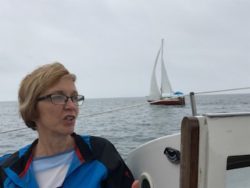
Every spring the youth group at our church holds a banquet where they auction off an assortment of great prizes to fund their summer mission trips. I bought a ticket for a chance to win a sailboat excursion on Lake Michigan. I’ve never sailed before, but I love to sit on our beach and watch the sailboats gliding gracefully across the lake, their white sails billowing. It looks like such a calm, peaceful way to travel. I never imagined I would win—but I did! Last weekend, my husband, our son Benjamin, and I claimed my prize.
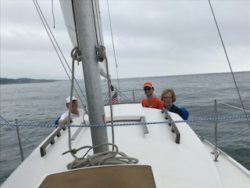
Lake Michigan was wonderfully calm, perfect for a first-timer like me. We set off in the afternoon with our host Bob Carlson on his sailboat named “Joy.” After a quick lesson, Benjamin served as his crew member as we navigated the channel at Port Sheldon, Michigan and sailed out into the big lake. The voyage was every bit as serene and lovely as I had imagined it would be as we headed north on a gentle wind. I began to dream of buying my own boat and learning how to sail it.

Eventually, the time came to turn around and sail home. Except that the wind had died down close to shore where we were sailing, and we came to a halt. We drifted for several minutes, unable to catch a good breeze, going nowhere. In order to get home, Bob said we needed to steer the boat farther out into the lake where the wind was stronger. I liked staying within sight of land where it seemed safe, but I also wanted to return home before nightfall. So we fired up the motor for a minute and steered out into deeper water. Sure enough, within a few minutes, our sails filled once again and we began moving swiftly toward home.
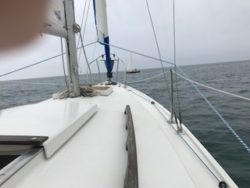
I was amazed by how a skilled sailor like Bob could “feel the wind,” as he put it, and use its power to go in whatever direction he chose. I recalled how Jesus compared the wind to the Holy Spirit, and I wondered if there were some lessons here on Lake Michigan for me. I know from experience that when I labor on my own, without the Spirit’s power, I get nowhere—just like our drifting sailboat. I also know the feeling of soaring with the Spirit’s help and accomplishing so much more than I could ever do on my own.
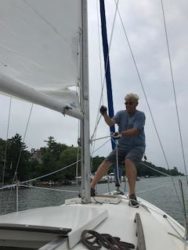
So why don’t I learn to “feel the wind” of the Spirt and harness its power more often? I suspect that sometimes it’s because I want to stay safe near the shore instead of venturing out into deeper, more dangerous waters. I feel more in control that way. What might God ask me to do if I surrendered control to Him? Yet with the wind’s power, we got to our destination much faster than we ever could have by rowing. And oh, what a glorious feeling it was when the wind filled our sails and we began to move! I imagine it was how Peter and the other disciples felt on the day of Pentecost when the Holy Spirt blew on them like a mighty, rushing wind.
The same power that changed the world is available to me. All I have to do is let it fill my sails.
July 17, 2017
Time to Pull Weeds

I know there are people who love to garden. They enjoy nurturing seeds, planting bulbs, and planning perennial beds so that gorgeous flowers flourish in every season. My neighbor is one of them. I walk past her home (in the photos above and below) and sigh with envy at her creativity and diligence.

I am not one of those people. While I do love the end result when my garden looks pristine and welcoming, I don’t enjoy doing the work to make it so. Nevertheless, I was forced to become the family gardener when my husband pulled a muscle in his shoulder. The weeds had no pity on his injury and quickly staged a take-over. Can anyone explain to me why weeds are so hearty and fast-growing while their beautiful, cultivated cousins need pampering? Or why the deer and the rabbits ignore the weeds and munch on my plants as if they’re a salad bar?

As I tackled our overgrown garden last week, it occurred to me that the process has some similarities to the way I write. My first drafts are usually an overgrown tangle of words. My strategy is to conquer the blank page and get something down, no matter how bad, and then go back and fix it later. It takes away some of the anxiety if I don’t stop to critique my work as I write. But the day eventually comes when I have to weed out the overgrown mess. Finding weeds in the garden is usually simple: if the roots seem to go down to China, it’s probably a weed. If it pulls out easily—oops! That was probably something expensive. And when I make my first editing pass on my manuscript, it’s easy to find the weeds, especially if I remind myself of the rules of good writing.
I ended up with a large recycling bin full of weeds by the time I finished pulling them, but the garden still looked overgrown. I needed to go back with my shears and trim away some of the good bushes and plants, too. I hate doing that because I’m always afraid I’m going to cut too much and kill the plant. It’s the same with my manuscript. Even after the weeds of poor grammar have been pulled, my beautiful prose sometimes needs to be trimmed. If I’m in an especially critical mood, I can come dangerously close to chopping away too much and ruining it. But it has to be done.

The photos above and below show the results of my gardening efforts. And while I hated to sacrifice writing time for the task, when I finally sat down to write again I was able to tackle some much-needed editing with renewed fervor.

Now what about weeding my spiritual garden? Jesus said, “I am the vine; you are the branches” and “my Father is the gardener. He cuts off every branch in me that bears no fruit, while every branch that does bear fruit he prunes so that it will be even more fruitful.” That sounds a lot like gardening and editing, doesn’t it? God is looking for fruit like love, joy, and patience—and not weeds like anger, gossip, and bitterness. If I hope to look like my neighbor’s garden in Jesus’ eyes, I think I have some work to do.

July 3, 2017
When Plans Change

My husband and I planned our summer vacation months ago. All spring, we’ve looked forward to exploring the wilds of Michigan’s Upper Peninsula with our friends, seeing Tahquamenon Falls, the Pictured Rocks National Lakeshore, the historic Grand Hotel on Mackinac Island, and taking a boat tour through the Soo Locks. But then a family medical emergency cancelled our plans. We’re thankful that God answered our prayers and the emergency ended well, but our trip will have to be postponed until next summer.
Our change in plans has started me thinking about some of the summer vacations we took with our children when they were small. One of the most memorable was a trip from our home in Winnipeg, Canada to Colorado’s Rocky Mountains, towing a borrowed pop-up trailer.  We awoke after our first night of camping to find that all four of the trailer’s tires had gone flat. After a trip into town to buy four new ones, we were on our way again. Once we arrived in the Rockies, we discovered that the trailer had a broken heater, so after a few very cold nights, we changed our plans and headed south to the Grand Canyon and warmer weather.
We awoke after our first night of camping to find that all four of the trailer’s tires had gone flat. After a trip into town to buy four new ones, we were on our way again. Once we arrived in the Rockies, we discovered that the trailer had a broken heater, so after a few very cold nights, we changed our plans and headed south to the Grand Canyon and warmer weather.
Somewhere around Durango, Colorado, several warning lights on our car’s dashboard began flashing. We made a detour to a repair shop and learned that the pop-up trailer had a faulty electrical system, which was draining our car’s battery. After more repairs and a new battery, we were on our way again.
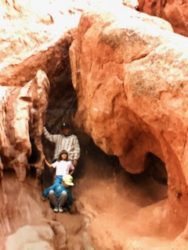
We showed up at the canyon at sunset, which is a beautiful time to arrive unless you need a campsite. All of the campgrounds were full. Signs throughout the park threatened enormous fines for camping anywhere except in designated sites. And it was a long, hot drive back to the nearest town.
Weary and desperate, we pulled into a parking lot behind a restaurant for the night. We didn’t dare to “pop up” the pop-up and risk a costly fine, so we decided to sleep in our car. All five of us. In our Toyota station wagon. Our sons Joshua and Benjamin slept in the two front seats, reclining them back as far as they would go. Ken and I emptied the luggage from the back of the car, folded down the rear seat, and slept there with our daughter, Maya. I use the term “slept” very loosely. “Dozed” is more like it as Ken and I folded ourselves around the wheel wells and tried to avoid Maya’s flailing arms and legs.
All night long, I expected to hear a dreaded knock on my window, and to face an angry park ranger ticketing us for not camping in a designated area. I planned to reply, “Does this look like we’re camping? If we were camping I would be asleep in the trailer behind us, not folded like a pretzel in our Toyota!” The long night ended without any fines. In fact by morning, the entire parking lot was filled with cars and trailers and rumpled families just like ours. I wasn’t the only one who didn’t know how hard it would be to find a campsite at the Grand Canyon.

We saw a lot of beautiful sites on that trip and had a lot of fun. For Ken and me, it was memorable because of the costly tires, the new battery, the electrical work, and the sleepless night. But when we asked the kids what they enjoyed most about that trip, guess what they said. “Sleeping in the car!” One of them asked if we could do it again.
I dislike change, especially when it collides with my well-laid plans. But it seems as though the unplanned, unexpected changes that come our way leave a deeper imprint in our memories than when everything goes according to schedule. I will get to Michigan’s Upper Peninsula another year. But in the aftermath of our medical emergency, I saw how beautifully our family pulls together and shows our deep love for one another. Our faith has been strengthened after sensing God’s presence throughout the crisis and knowing that He hears and answers our prayers. In the end, that’s worth much more to me than a pile of vacation photos.
Where have you seen God at work when your plans were changed?
June 19, 2017
The notice in the newspaper intrigued me. It called for ...

The notice in the newspaper intrigued me. It called for volunteers to help with a hot air balloon race, which was taking place in a few days in a nearby park. I remember thinking, “Hmmm. Maybe I could use this experience in a novel someday.” We lived in Winnipeg, Manitoba, Canada at the time, and my children were small, but I talked my family into volunteering with me, thinking it might be a fun experience. And it was!
We were assigned to a balloonist on the day of the race, and our first task was to help him unload the wicker gondola, burners, fans and a huge canvas bag from the back of his pickup truck. Then we set to work pulling the enormous balloon from the bag and spreading it out on the ground. And I do mean enormous! It could have covered our entire house. Next, we set up fans in front of the balloon’s opening and held it open like a huge mouth until the cavity was filled with air. My husband and another volunteer held onto the guide ropes at the top of the balloon so it wouldn’t blow away before we were ready.
Meanwhile, the balloonist set up the gondola and burners, and attached them to the balloon, which was rising up as it filled with air as if coming to life after a long slumber. In fact, we were surrounded by swelling balloons on all sides. What a magnificent sight!
The balloonist had warned us to cover our ears when he fired the burners but I forgot, and the sudden roar made me jump out of my shoes. The warm air from the burners gave the balloon lift and it rose to its full height, tugging against the ground ropes as if ready to soar. It was time for the pilot to jump aboard and take off along with all the others. They would be sailing on the wind and following a chase balloon, which would be dropping a marker flag somewhere in the countryside, wherever the wind took it. The balloon that managed to drop a flag closest to the marker would be the winner.
Our pilot’s gondola was very small, so none of us got to ride with him. But as soon as he took off we became his chase team, following along behind him in his pickup truck so he wouldn’t be stranded in the middle of nowhere when his fuel ran out. The chase was an adventure in itself! We had to watch the skies and the roadway at the same time, always trying to keep the balloon in sight. Winnipeg is divided by two rivers, so we had to backtrack a few times in order to find a bridge across them. Things got exciting with all three kids searching the skies until we spotted our balloon once again.
It landed safely in a farmer’s field outside of town, and he was very happy to see us roll up a few minutes later in his truck. After we helped him stuff the gigantic balloon back into the bag and reload all of the equipment, he drove us to the park to retrieve our car. All in all, it was a fun way to spend a summer evening, and the experience of a lifetime for our family. Years later, one of our kids confessed that he took adventures like that one for granted when he was young. It wasn’t until he spent time with his school friends that he realized not everyone’s mother was a crazy writer who volunteered for outrageous experiences like this.

And guess what? If you read my newest book, “Fly Away,” you’ll find that my characters also volunteer for a hot air balloon race. Nothing is ever wasted in the life of a writer! “Fly Away” was successfully launched four days ago as an e-book and in print. An audio version is also in the works. It tells the stories of two very different people—one learning how to live and the other how to die. But it isn’t a sad book at all. In fact, my early readers tell me they laughed out loud in places. If you would like to enter for a chance to win one of two free copies, be sure to join my newsletter by adding your email in the box on the right side of the screen and leave me a comment below.
And while you’re waiting to see if you win, be sure to check your local newspaper like I did to see if there are any interesting adventures you can volunteer for. You don’t have to be a crazy writer (or one of her children) to have fun. Enjoy!

June 5, 2017
Time to Fly Away
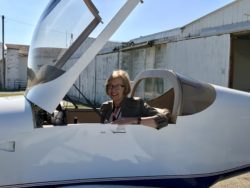
It’s nearly time for lift off! I’m happy to announce that my novel, “Fly Away” is coming soon on June 15 in both print and ebook versions. Since one of the main characters, Mike Dolan, is a pilot who owns a small, charter airplane business, I visited a local airport with my friends Susan, Bruce, and Doug Formsma to celebrate. Doug was kind enough to let me pose in his airplane.
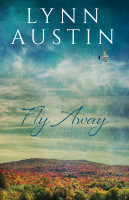
The first thing you’ll notice about “Fly Away” is that it takes place in 1987. That time period is too new to be a historical novel like most of my other books, but too old to be a contemporary novel. That’s because “Fly Away” was one of the very first books I wrote when I was just starting to dream of being a writer. The story came to me so effortlessly that I remember writing it out longhand on a yellow legal pad. Later, I typed it into my computer and saved it on several 3 ½ inch floppy discs. It was published by Beacon Hill Press in 1996 and has since gone out of print.
I remember very well the genesis of the story. Within a short period of time, our family struggled with a series of losses. My father, a World War II veteran like the main character in “Fly Away,” was hospitalized with a stroke and died a few months later at the age of 62. Dad had been caring for my grandmother so she had to be moved to a nursing home. My father-in-law also had a stroke and was moved to a nursing home because my mother-in-law was diagnosed with terminal colon cancer. Mom and Dad Austin both passed away within a few months of each other.
My husband and I and our three children drove down to Michigan from our home in Canada to take care of my mother-in-law in her final weeks so she could remain at home rather than be hospitalized. Our daughter Maya was a newborn when we left Canada and one month old when Mom died. We took care of Mom and Maya simultaneously, one at the very beginning of her life, the other at the end; one growing stronger each day, the other weaker. After just experiencing the miracle of birth, we learned that death is also one of God’s holy moments.
As you read “Fly Away” you’ll probably see how my own thoughts and emotions became intertwined with my plot and characters. The book deals with dying and loss, but I didn’t want it to be a sad book. All of my beloved family members had loved life and lived it well. They taught me that our faith in Christ gives us the strength and courage we need to face whatever plans He has for us—even when it means saying goodbye.
Telephones still had cords when I wrote “Fly Away” and hung on kitchen walls. Shag carpeting and Star Wars figures were all the rage. But I hope you’ll find that the themes of God’s goodness and love are timeless. Enjoy!

May 15, 2017
Best Friends
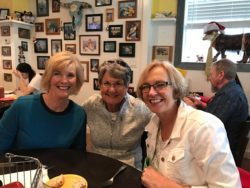
Everyone needs a best friend—someone to laugh with, cry with, and do fun and crazy things with. Today I’m celebrating some of my dearest friends.

Friends like Cathy who has an amazing sense of fashion and loves to go shopping with me. I was tired of my same old dreary clothes, so Cathy trolled through my closet with me and helped me decide what I should donate to charity. Then we went shopping to re-fill all those empty clothes hangers. It was especially fun to find a 60% off sale in one of our favorite stores! I had a ball trying on clothes and buying a new outfit for an upcoming speaking event. Cathy is the one who first encouraged me to speak at church events years ago. She prayed with me and gave me the courage to do it.
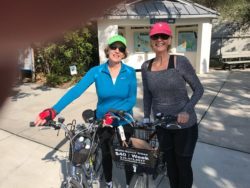
She is also my biking buddy. Along with our husbands, Cathy and I biked more than 200 miles while on vacation in Florida last January.
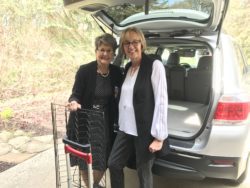
My friend Jacki went with me to two of my speaking events recently, driving me and helping me haul all of my books inside, set them up, and then sell them. I consider that “going the extra mile” for friendship’s sake.
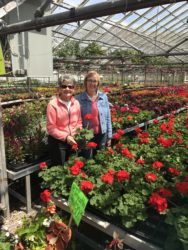
We also went to a greenhouse together and bought flowers for our gardens. They were so beautiful and colorful and fragrant, it was like taking a mini-vacation. It’s so much more fun to do everyday things like this together.
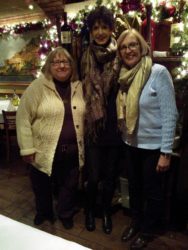
And these are my faithful writer friends, Jane and Cleo. We have been meeting to share our lives and critique each other’s writing for more than 25 years. When we began, none of us were published—and none of our children were married. Now we all have multiple books to our credit—and multiple grandchildren!
We have celebrated each publishing milestone and cried with each other through our many disappointments. We brainstorm plots and titles together—and we laugh a lot. And eat a lot. This Indian restaurant is one of our favorite places to go for our writers’ meetings.
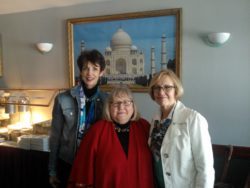
Where would any of us be without our friends? I know my life would be much lonelier without them. If you have friends who are dear to you, I hope you’ll take a moment this week to tell them how much they mean to you, and to celebrate God’s gift of friendship.
May 1, 2017
From Small Beginnings

I had the privilege last week of speaking to a wonderful group of women who volunteer for the International Bible League, an organization I love to support. I told them my story—how I sat down and started writing my first novel 31 years ago, even though I had no formal training, no clue how to get published, and three small children at home. I wanted my audience to know that they shouldn’t be afraid to trust God when He nudges them to step out in a new direction. He is able to do “immeasurably more than all we ask or imagine” (Ephesians 3:20). I told them my story, but I also shared two other stories with them.
The first is about a Canadian mom named Fern Nichols. In 1984 her two oldest children were starting junior high school and she feared that their faith would be tested as they faced immoral values and peer pressure. She prayed for God to protect her children, and asked Him to send another mom to pray with her. He did! More moms joined them, and the group began meeting regularly to pray for their children and schools. The idea spread all across their province of British Columbia.
The following year, Fern’s family moved to California. Once again she prayed that God would raise up mothers willing to pray for their children. Again, these prayer groups multiplied, spreading around the state and across the nation.
That is how “Moms In Touch” began, now renamed “Moms in Prayer International.” Today, groups of mothers are praying in every state in the USA and in more than 140 countries. My neighbor, Marlae Gritter, joined a small prayer group years ago when her children were school-aged. She never imagined that today she would be the Director of Global Advancement for the international group. Below is a picture of Marlae and me with our new friend Kathrin Larsen from Switzerland. Kathrin also started out as a praying mom, and is now the European Director of the organization.

The second story I told my audience is about a man named William Chapman. In 1936, he became seriously ill and landed in a Chicago hospital. An elder from his church visited and prayed not only for William’s life to be spared, but that he would be led into the service of Christ.
“At the time, it seemed a strange prayer,” Bill said. “Why should God be asked to give me health and strength for this purpose? What could I possibly do for Christ? I came to the conclusion that this was a ridiculous prayer. But as the night wore on toward morning, it became increasingly apparent that my elder’s prayer could not be easily forgotten. That’s when I made my commitment to God. If God would restore my health, I would give all my strength in any avenue of service God would lead.”
William and his wife Betty purchased 1,000 Bibles and went door-to-door in Walkerton, Indiana asking, “Do you have a Bible?” If the home didn’t, they offered one for free if the owners promised to read it. From this simple beginning, William Chapman went on to form the “Bible League International,” the organization I was speaking to. Today, the “Bible League” shares Bibles and Bible study training tools in countries all around the world.

Thirty-one years ago, I laid aside my fears and excuses and started writing. Today I have 24 published books in a dozen different languages. I urged my audience not to ignore God’s little nudges. I invited them to step out in faith and to trust God, and then wait to see the amazing things He is able to do through them. I think William Chapman, Fern Nichols, my neighbor Marlae, and our Swiss friend Kathrin would all agree that “No eye has seen, no ear has heard, no mind has conceived what God has prepared for those who love Him.” (1 Corinthians 2:9).

Have you felt God’s gentle nudging in your life lately?
April 17, 2017
Read to Me!
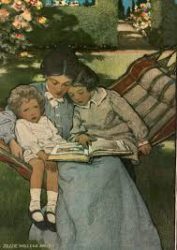
One of the things I love about being a grandmother is reading books to my granddaughter. Lyla is sixteen months old and already has her favorites. One of them, “Hand, Hand, Fingers Thumbs” by Al Perkins and Eric Gurney, used to be one of her mother’s favorites, too. 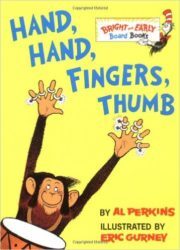 I never liked this book when my daughter was young because it didn’t have a plot. My daughter now understands why I got tired of reading it over and over, and has even resorted to hiding the book from Lyla. Ironically, I could read it to my granddaughter all day!
I never liked this book when my daughter was young because it didn’t have a plot. My daughter now understands why I got tired of reading it over and over, and has even resorted to hiding the book from Lyla. Ironically, I could read it to my granddaughter all day!
When Lyla gets a little older, I’ll introduce her to another of her mother’s favorites, “Millions of Cats” by Wanda Gag. 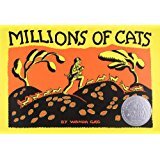 It’s about a sweet husband who sets off to find a kitten for his wife and, when he can’t make up his mind which one to choose, returns with “hundreds of cats, thousands of cats, millions and billions and trillions of cats.” His astounded wife says, “But we can never feed them all!”
It’s about a sweet husband who sets off to find a kitten for his wife and, when he can’t make up his mind which one to choose, returns with “hundreds of cats, thousands of cats, millions and billions and trillions of cats.” His astounded wife says, “But we can never feed them all!”
I have a theory that the books we love as children offer hints about the adults we’ll later become, and also help to shape us. My daughter still loves cats, and she visits the local animal shelter often. Like the husband in the story, she would gladly bring all of the cats home if not for the problem of feeding them. A few years ago, she agreed to foster a cat for a few days because he was too rambunctious for the tiny shelter—and Dexter is now a beloved family member.

So I started thinking about my childhood favorites and why I liked them. “The Boxcar Children” by Gertrude Chandler Warner, tells about a family of orphans who make a home in an abandoned railroad boxcar and learn to fend for themselves. 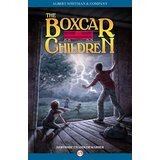 I was never orphaned but my mother did become gravely ill when I was a child and had to be hospitalized. My sisters and I lived with my grandparents until she recovered. I wasn’t wise enough to realize it then, but I think “The Boxcar Children” appealed to me because the children not only survived the trauma but even flourished. And how fun to make over a boxcar! Just like my favorite TV show, “Fixer-Upper!”
I was never orphaned but my mother did become gravely ill when I was a child and had to be hospitalized. My sisters and I lived with my grandparents until she recovered. I wasn’t wise enough to realize it then, but I think “The Boxcar Children” appealed to me because the children not only survived the trauma but even flourished. And how fun to make over a boxcar! Just like my favorite TV show, “Fixer-Upper!”
Another book I enjoyed was “The Borrowers” by Mary Norton.  It’s about the little people who live in the walls of our houses and “borrow” objects from us to furnish their own homes. It explains why so many things go missing, like buttons and spools of thread. The borrowers needed that button for a dinner plate and the spool for a table! Even now, the borrowers provide a handy explanation for all the items I lose. And this book either fed into or created my love for “repurposing” items that others discard. Like a giant-sized “borrower,” I love to scour thrift stores and garage sales searching for treasures to fix and paint and resurrect—like this broken-down bedside table that I turned into a filing cabinet. The plant stand was also a thrift store find.
It’s about the little people who live in the walls of our houses and “borrow” objects from us to furnish their own homes. It explains why so many things go missing, like buttons and spools of thread. The borrowers needed that button for a dinner plate and the spool for a table! Even now, the borrowers provide a handy explanation for all the items I lose. And this book either fed into or created my love for “repurposing” items that others discard. Like a giant-sized “borrower,” I love to scour thrift stores and garage sales searching for treasures to fix and paint and resurrect—like this broken-down bedside table that I turned into a filing cabinet. The plant stand was also a thrift store find.
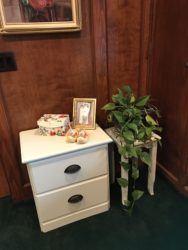
Another favorite book that I’m eager to share with Lyla is “The Tale of Peter Rabbit” by Beatrix Potter.  Peter and his siblings are warned not to go near Farmer McGregor’s garden lest they be caught and made into rabbit pie. The good little bunnies heed the warning and stay home. Peter doesn’t. As a child, I almost always obeyed the rules and was horrified by those who didn’t. I shouldn’t have liked this book—yet I did. Peter gets caught by the farmer and only narrowly escapes. He’s punished for disobeying, which appealed to my sense of justice and fairness. But oh, what an exciting adventure Peter had that day! The story provided a way for me to break the rules and be naughty, risking danger and adventure—and yet remain safe.
Peter and his siblings are warned not to go near Farmer McGregor’s garden lest they be caught and made into rabbit pie. The good little bunnies heed the warning and stay home. Peter doesn’t. As a child, I almost always obeyed the rules and was horrified by those who didn’t. I shouldn’t have liked this book—yet I did. Peter gets caught by the farmer and only narrowly escapes. He’s punished for disobeying, which appealed to my sense of justice and fairness. But oh, what an exciting adventure Peter had that day! The story provided a way for me to break the rules and be naughty, risking danger and adventure—and yet remain safe.
And isn’t that what reading good books still do? They take us to exotic places and time periods where we meet dangerous people who live extraordinary lives—without ever leaving our armchairs. I can’t wait to read all the books I once treasured to my granddaughter, and relive those adventures all over again!
So, what were your favorite books as a child? Can you see how they may have influenced who you are today?
April 3, 2017
Living Boldly

If you lived in the age of the explorers, would you have had the courage to sail across the ocean on a ship like this one? I toured the Maritime Museum of San Diego on our trip to California last week, and as I stood on the deck of the San Salvador, a replica of a Spanish Galleon from 1542, I asked myself that question.

The ship is less than 100 feet long and only 32 feet wide, and seemed much too small to cross the Atlantic Ocean from Spain, travel around the tip of South America to the Pacific Ocean, and then sail up the California coast. But that’s exactly what the early explorers did as they sailed to the New World.

Or how about setting sail on this ship, the Star of India? It was also on display at the museum, and carried passengers from Great Britain to New Zealand in the mid-1800s. That voyage around the southern tip of Africa lasted five months! I tried to imagine being stuffed into the cramped space below deck with my entire family in stormy seas, and wondered what drew people to immigrate to new lands at such great risk.

We also toured the California Science Center in Los Angeles where the space shuttle Endeavour is on display. What amazing courage it must take to embark on such a voyage! I can say with certainty that a trip to outer space isn’t for me. I had to endure an hour and a half of stomach-churning turbulence on our flight home from California and that was adventure enough!
So why are some people willing to “boldly go where no man has gone before” as they used to say on the TV series Star Trek? Where does that adventurous spirit come from? I once heard a rabbi speak on the creation story in Genesis and he had an interesting interpretation of the verse where God commands Adam and Eve to fill the newly-created earth and “subdue” it. The rabbi believed that subduing the earth means we’re supposed to use our natural curiosity and sense of adventure to explore the world and learn everything we can about it, much like my one-year-old granddaughter who toddles around the backyard wide-eyed, examining every leaf and stick and ant with a sense of wonder. It’s part of our nature to continue to learn and grow, to explore new places, and challenge ourselves to try new things. But as we get older we become conditioned by fear and our desire for comfort, and so we set aside our natural curiosity to remain “safe.”
If I’m not careful, I can lose that sense of newness and awe in my spiritual life, as well, and become what Eugene Peterson calls a mere “spectator and consumer” rather than an actively growing Christian. In his wonderful book about the life of Jeremiah entitled “Run With the Horses,” Peterson says: “The aim of the person of faith is not to be as comfortable as possible but to live as deeply and thoroughly as possible—to deal with the reality of life, discover truth, create beauty, act out love.” That sounds very dangerous and risky, doesn’t it? Like crossing the ocean in a flimsy schooner or being launched into space. But in order to truly love others as Christ does, it’s going to require fearlessness and risk-taking. We may have to leave our comfort zone and reach out to people who aren’t like us.
And yet if I trust Jesus’ promise that He will never leave me or forsake me, shouldn’t I be fearless? Shouldn’t I be willing to risk going boldly through life, dealing with its realities, living deeply, loving others? Will I be as courageous as the early explorers or prefer to remain safe, becoming a spiritual “spectator and consumer?” Peterson also says, “The only opportunity you will ever have to live by faith is in the circumstances you are provided this very day.”
As you and I look around at the circumstances we find ourselves in today, are we willing to step out boldly and live by faith? Jesus said, “I tell you the truth, if you have faith as small as a mustard seed, you can say to this mountain, ‘Move from here to there’ and it will move. Nothing will be impossible for you.” Let’s move some mountains today!
March 20, 2017
The Sabbath Table

One of my favorite weekend pastimes is celebrating the Sabbath with our Jewish family and friends. In the hours before I arrive, they will have been hard at work baking bread and preparing enough food to last for the next 24 hours. The table is beautifully set, and the aromas that waft from the kitchen make my stomach rumble. I sit down to enjoy the long, leisurely meal with a huge sigh of relief, knowing that a full day of rest lies ahead of me, one in which I don’t have to race around multi-tasking or accomplishing everything my to-do lists. All of the preparations have been completed.
The host begins the meal by saying a blessing over the bread. There are always two loaves as a reminder that when the Israelites wandered in the wilderness with Moses, God provided twice as much manna on the eve of the Sabbath so the people could enjoy a day of rest. Our host breaks the bread into pieces and passes it around to everyone at the table. Next he says the blessing over the wine, which is also passed around. The rituals of bread and wine remind me of communion and Christ’s command to “Do this in remembrance of me.” I can easily picture Jesus’ disciples remembering His words and His sacrifice every Sabbath as they repeated this tradition.
One of the Ten Commandments says to “Remember the Sabbath day to keep it holy,” meaning it should be different and set apart from ordinary days. The Sabbath food is special and often costly. We dress in our nicest clothes. There is singing and laughter and joy as we take our time eating and enjoying our family members and friends. Or to use an old-fashioned word, “communing” with them. I usually don’t want the Sabbath meal to end.
Last Sunday we celebrated Communion at our church. I arrived frazzled and overwhelmed after a terrible week. I felt wounded and defeated. Then our pastor repeated Christ’s words over the bread and wine, and invited the congregation to come to “Christ’s table.” This traditional invitation struck me in a brand new way. I heard Christ inviting me to His table—a Sabbath table. He had completed all the work. The bread and wine had been bought with a great price. Now He invited me to come and to enjoy a time of close fellowship with Him. I heard His words as an invitation to rest, and more importantly, to rest in Him. I could stop struggling and striving. I was His beloved. I didn’t have to do any work to earn His favor except to believe and accept His invitation.
My picture of the Sabbath table merged with the Communion table. I now think I understand Christ’s invitation in Matthew 11:28 a little better: “Come to me, all you who are weary and burdened, and I will give you rest.” It’s an invitation well worth accepting.



